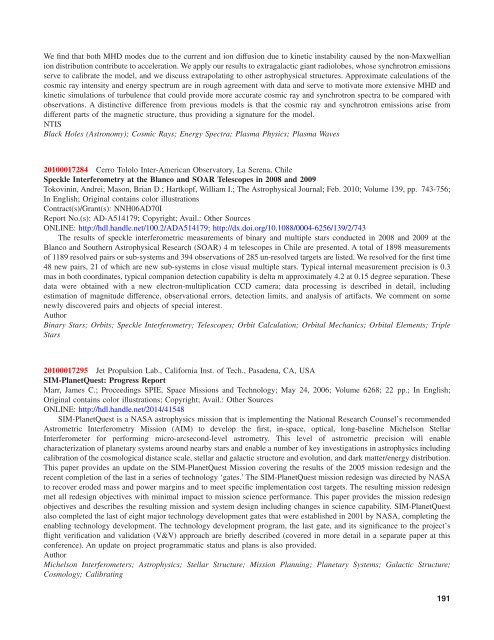NASA Scientific and Technical Aerospace Reports - The University ...
NASA Scientific and Technical Aerospace Reports - The University ...
NASA Scientific and Technical Aerospace Reports - The University ...
You also want an ePaper? Increase the reach of your titles
YUMPU automatically turns print PDFs into web optimized ePapers that Google loves.
We find that both MHD modes due to the current <strong>and</strong> ion diffusion due to kinetic instability caused by the non-Maxwellian<br />
ion distribution contribute to acceleration. We apply our results to extragalactic giant radiolobes, whose synchrotron emissions<br />
serve to calibrate the model, <strong>and</strong> we discuss extrapolating to other astrophysical structures. Approximate calculations of the<br />
cosmic ray intensity <strong>and</strong> energy spectrum are in rough agreement with data <strong>and</strong> serve to motivate more extensive MHD <strong>and</strong><br />
kinetic simulations of turbulence that could provide more accurate cosmic ray <strong>and</strong> synchrotron spectra to be compared with<br />
observations. A distinctive difference from previous models is that the cosmic ray <strong>and</strong> synchrotron emissions arise from<br />
different parts of the magnetic structure, thus providing a signature for the model.<br />
NTIS<br />
Black Holes (Astronomy); Cosmic Rays; Energy Spectra; Plasma Physics; Plasma Waves<br />
20100017284 Cerro Tololo Inter-American Observatory, La Serena, Chile<br />
Speckle Interferometry at the Blanco <strong>and</strong> SOAR Telescopes in 2008 <strong>and</strong> 2009<br />
Tokovinin, Andrei; Mason, Brian D.; Hartkopf, William I.; <strong>The</strong> Astrophysical Journal; Feb. 2010; Volume 139, pp. 743-756;<br />
In English; Original contains color illustrations<br />
Contract(s)/Grant(s): NNH06AD70I<br />
Report No.(s): AD-A514179; Copyright; Avail.: Other Sources<br />
ONLINE: http://hdl.h<strong>and</strong>le.net/100.2/ADA514179; http://dx.doi.org/10.1088/0004-6256/139/2/743<br />
<strong>The</strong> results of speckle interferometric measurements of binary <strong>and</strong> multiple stars conducted in 2008 <strong>and</strong> 2009 at the<br />
Blanco <strong>and</strong> Southern Astrophysical Research (SOAR) 4 m telescopes in Chile are presented. A total of 1898 measurements<br />
of 1189 resolved pairs or sub-systems <strong>and</strong> 394 observations of 285 un-resolved targets are listed. We resolved for the first time<br />
48 new pairs, 21 of which are new sub-systems in close visual multiple stars. Typical internal measurement precision is 0.3<br />
mas in both coordinates, typical companion detection capability is delta m approximately 4.2 at 0.15 degree separation. <strong>The</strong>se<br />
data were obtained with a new electron-multiplication CCD camera; data processing is described in detail, including<br />
estimation of magnitude difference, observational errors, detection limits, <strong>and</strong> analysis of artifacts. We comment on some<br />
newly discovered pairs <strong>and</strong> objects of special interest.<br />
Author<br />
Binary Stars; Orbits; Speckle Interferometry; Telescopes; Orbit Calculation; Orbital Mechanics; Orbital Elements; Triple<br />
Stars<br />
20100017295 Jet Propulsion Lab., California Inst. of Tech., Pasadena, CA, USA<br />
SIM-PlanetQuest: Progress Report<br />
Marr, James C.; Proceedings SPIE, Space Missions <strong>and</strong> Technology; May 24, 2006; Volume 6268; 22 pp.; In English;<br />
Original contains color illustrations; Copyright; Avail.: Other Sources<br />
ONLINE: http://hdl.h<strong>and</strong>le.net/2014/41548<br />
SIM-PlanetQuest is a <strong>NASA</strong> astrophysics mission that is implementing the National Research Counsel’s recommended<br />
Astrometric Interferometry Mission (AIM) to develop the first, in-space, optical, long-baseline Michelson Stellar<br />
Interferometer for performing micro-arcsecond-level astrometry. This level of astrometric precision will enable<br />
characterization of planetary systems around nearby stars <strong>and</strong> enable a number of key investigations in astrophysics including<br />
calibration of the cosmological distance scale, stellar <strong>and</strong> galactic structure <strong>and</strong> evolution, <strong>and</strong> dark matter/energy distribution.<br />
This paper provides an update on the SIM-PlanetQuest Mission covering the results of the 2005 mission redesign <strong>and</strong> the<br />
recent completion of the last in a series of technology ‘gates.’ <strong>The</strong> SIM-PlanetQuest mission redesign was directed by <strong>NASA</strong><br />
to recover eroded mass <strong>and</strong> power margins <strong>and</strong> to meet specific implementation cost targets. <strong>The</strong> resulting mission redesign<br />
met all redesign objectives with minimal impact to mission science performance. This paper provides the mission redesign<br />
objectives <strong>and</strong> describes the resulting mission <strong>and</strong> system design including changes in science capability. SIM-PlanetQuest<br />
also completed the last of eight major technology development gates that were established in 2001 by <strong>NASA</strong>, completing the<br />
enabling technology development. <strong>The</strong> technology development program, the last gate, <strong>and</strong> its significance to the project’s<br />
flight verification <strong>and</strong> validation (V&V) approach are briefly described (covered in more detail in a separate paper at this<br />
conference). An update on project programmatic status <strong>and</strong> plans is also provided.<br />
Author<br />
Michelson Interferometers; Astrophysics; Stellar Structure; Mission Planning; Planetary Systems; Galactic Structure;<br />
Cosmology; Calibrating<br />
191

















